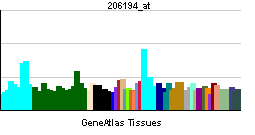HOXC4
| Homeobox C4 | |||||||||||
|---|---|---|---|---|---|---|---|---|---|---|---|
| Identifiers | |||||||||||
| Symbols | HOXC4 ; HOX3; HOX3E; cp19 | ||||||||||
| External IDs | Template:OMIM5 Template:MGI HomoloGene: 8408 | ||||||||||
| |||||||||||
| RNA expression pattern | |||||||||||
 | |||||||||||
| More reference expression data | |||||||||||
| Orthologs | |||||||||||
| Template:GNF Ortholog box | |||||||||||
| Species | Human | Mouse | |||||||||
| Entrez | n/a | n/a | |||||||||
| Ensembl | n/a | n/a | |||||||||
| UniProt | n/a | n/a | |||||||||
| RefSeq (mRNA) | n/a | n/a | |||||||||
| RefSeq (protein) | n/a | n/a | |||||||||
| Location (UCSC) | n/a | n/a | |||||||||
| PubMed search | n/a | n/a | |||||||||
Homeobox C4, also known as HOXC4, is a human gene.[1]
This gene belongs to the homeobox family of genes. The homeobox genes encode a highly conserved family of transcription factors that play an important role in morphogenesis in all multicellular organisms. Mammals possess four similar homeobox gene clusters, HOXA, HOXB, HOXC and HOXD, which are located on different chromosomes and consist of 9 to 11 genes arranged in tandem. This gene, HOXC4, is one of several homeobox HOXC genes located in a cluster on chromosome 12. Three genes, HOXC5, HOXC4 and HOXC6, share a 5' non-coding exon. Transcripts may include the shared exon spliced to the gene-specific exons, or they may include only the gene-specific exons. Two alternatively spliced variants that encode the same protein have been described for HOXC4. Transcript variant one includes the shared exon, and transcript variant two includes only gene-specific exons.[1]
See also
References
Further reading
- Scott MP (1992). "Vertebrate homeobox gene nomenclature". Cell. 71 (4): 551–3. PMID 1358459.
- McAlpine PJ, Shows TB (1990). "Nomenclature for human homeobox genes". Genomics. 7 (3): 460. PMID 1973146.
- Acampora D, D'Esposito M, Faiella A; et al. (1990). "The human HOX gene family". Nucleic Acids Res. 17 (24): 10385–402. PMID 2574852.
- Boncinelli E, Acampora D, Pannese M; et al. (1990). "Organization of human class I homeobox genes". Genome. 31 (2): 745–56. PMID 2576652.
- Rabin M, Ferguson-Smith A, Hart CP, Ruddle FH (1987). "Cognate homeo-box loci mapped on homologous human and mouse chromosomes". Proc. Natl. Acad. Sci. U.S.A. 83 (23): 9104–8. PMID 2878432.
- Simeone A, Pannese M, Acampora D; et al. (1988). "At least three human homeoboxes on chromosome 12 belong to the same transcription unit". Nucleic Acids Res. 16 (12): 5379–90. PMID 2898768.
- Adams MD, Kerlavage AR, Fleischmann RD; et al. (1995). "Initial assessment of human gene diversity and expression patterns based upon 83 million nucleotides of cDNA sequence". Nature. 377 (6547 Suppl): 3–174. PMID 7566098.
- Meazza R, Faiella A, Corsetti MT; et al. (1995). "Expression of HOXC4 homeoprotein in the nucleus of activated human lymphocytes". Blood. 85 (8): 2084–90. PMID 7718879.
- Rieger E, Bijl JJ, van Oostveen JW; et al. (1994). "Expression of the homeobox gene HOXC4 in keratinocytes of normal skin and epithelial skin tumors is correlated with differentiation". J. Invest. Dermatol. 103 (3): 341–6. PMID 7915745.
- Apiou F, Flagiello D, Cillo C; et al. (1996). "Fine mapping of human HOX gene clusters". Cytogenet. Cell Genet. 73 (1–2): 114–5. PMID 8646877.
- Bijl JJ, Rieger E, van Oostveen JW; et al. (1997). "HOXC4, HOXC5, and HOXC6 expression in primary cutaneous lymphoid lesions. High expression of HOXC5 in anaplastic large-cell lymphomas". Am. J. Pathol. 151 (4): 1067–74. PMID 9327740.
- Schild-Poulter C, Pope L, Giffin W; et al. (2001). "The binding of Ku antigen to homeodomain proteins promotes their phosphorylation by DNA-dependent protein kinase". J. Biol. Chem. 276 (20): 16848–56. doi:10.1074/jbc.M100768200. PMID 11279128.
- Kosaki K, Kosaki R, Suzuki T; et al. (2002). "Complete mutation analysis panel of the 39 human HOX genes". Teratology. 65 (2): 50–62. doi:10.1002/tera.10009. PMID 11857506.
- Strausberg RL, Feingold EA, Grouse LH; et al. (2003). "Generation and initial analysis of more than 15,000 full-length human and mouse cDNA sequences". Proc. Natl. Acad. Sci. U.S.A. 99 (26): 16899–903. doi:10.1073/pnas.242603899. PMID 12477932.
- Schaffer A, Kim EC, Wu X; et al. (2003). "Selective inhibition of class switching to IgG and IgE by recruitment of the HoxC4 and Oct-1 homeodomain proteins and Ku70/Ku86 to newly identified ATTT cis-elements". J. Biol. Chem. 278 (25): 23141–50. doi:10.1074/jbc.M212952200. PMID 12672812.
- Kim EC, Edmonston CR, Wu X; et al. (2004). "The HoxC4 homeodomain protein mediates activation of the immunoglobulin heavy chain 3' hs1,2 enhancer in human B cells. Relevance to class switch DNA recombination". J. Biol. Chem. 279 (40): 42258–69. doi:10.1074/jbc.M407496200. PMID 15252056.
- Speleman F, Cauwelier B, Dastugue N; et al. (2005). "A new recurrent inversion, inv(7)(p15q34), leads to transcriptional activation of HOXA10 and HOXA11 in a subset of T-cell acute lymphoblastic leukemias". Leukemia. 19 (3): 358–66. doi:10.1038/sj.leu.2403657. PMID 15674412.
- Kimura K, Wakamatsu A, Suzuki Y; et al. (2006). "Diversification of transcriptional modulation: large-scale identification and characterization of putative alternative promoters of human genes". Genome Res. 16 (1): 55–65. doi:10.1101/gr.4039406. PMID 16344560.
- Wissmüller S, Kosian T, Wolf M; et al. (2006). "The high-mobility-group domain of Sox proteins interacts with DNA-binding domains of many transcription factors". Nucleic Acids Res. 34 (6): 1735–44. doi:10.1093/nar/gkl105. PMID 16582099.
External links
- HOXC4+protein,+human at the US National Library of Medicine Medical Subject Headings (MeSH)
This article incorporates text from the United States National Library of Medicine, which is in the public domain.
| This protein-related article is a stub. You can help Wikipedia by expanding it. |